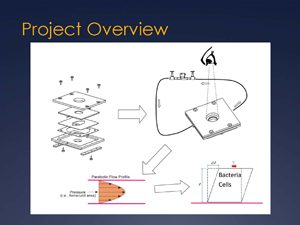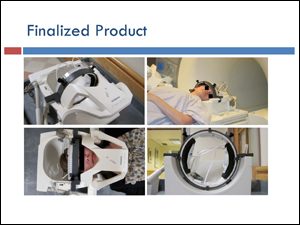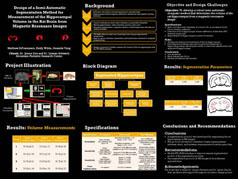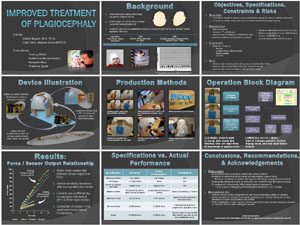Undergraduate Research Opportunities
 Undergraduate research is considered a central feature of the undergraduate Bioengineering program. Accordingly, students are given the opportunity to integrate a vast number or research activities into their undergraduate curriculum. This includes the flexibility of joining research labs in the medical school, veterinary school, or any of the various other schools, centers, and departments on campus. Finding research opportunities can be as easy as emailing a professor or enrolling in a course. Several popular course options are described below.
Undergraduate research is considered a central feature of the undergraduate Bioengineering program. Accordingly, students are given the opportunity to integrate a vast number or research activities into their undergraduate curriculum. This includes the flexibility of joining research labs in the medical school, veterinary school, or any of the various other schools, centers, and departments on campus. Finding research opportunities can be as easy as emailing a professor or enrolling in a course. Several popular course options are described below.
Research in the Curriculum
Part of the senior year curriculum includes a year-long Senior Design research project that ensures all of our students learn to utilize fundamental engineering skills to solve complex medical problems. As a result of these experiences, about 20 percent of the undergraduates that graduate with Bioengineering degrees publish their research findings in peer-reviewed journals. All BE undergraduates take either BE495 / BE 496 Senior Design or BE497 / BE 498 Senior Thesis, which are year-long hands-on research and/or design experiences under the supervision of a faculty member.
Independent Study
In addition to Senior Design or Senior Thesis, you may take up to two more independent study courses in research towards your degree (BE 099, 490, 492).
Collaborating with Faculty
Students do research not only with Bioengineering faculty, but with faculty across the university, whether in the medical school, hospitals, or the many research centers at Penn, all within walking distance from each other. For more information on beginning research as an undergraduate, the Penn student chapter of the Biomedical Engineering Society (BMES) has assembled its own student guide, which you can download here.
Interdisciplinary Research
Students in the BAS program or pursuing a dual degree, may want to do research in areas like the economics of health or biotechnology start-ups.
Undergraduate Publications
Many students publish their research while they are still undergraduates. Every student does a year-long senior design project, but many conduct more than one research project or engage in research for more than two semesters. You can see a list of student publications here.
Undergraduate Research Spotlight:
 Bacterial adhesion to biomimmetic surfaces
Bacterial adhesion to biomimmetic surfaces
Students: Stephanie Klebba, Amy Silverstein, Vincent Valant
Advisors: Dr. Composto and Dr. Eckmann
Implants placed into the human body are susceptible to the buildup of bacterial films and infection. We designed and built a laminar flow imaging chamber that can be used to measure bacterial and cellular adhesion to various implantable materials and surface coatings. The chamber consists of anodized aluminum plates closed with four screws to create a flow bath within a silicone gasket, sandwiched by a cover slip and a sample material. The material sample is held in place by various sizes of inserts and the fluid is pumped across the material, within the gasket, through holes in the upper plate. The chamber is compatible with various methods of microscopy needed to observe cells and bacteria under fluid flow and shear stress conditions.
Undergraduate Research Spotlight:
 Cervical spine positioning device for MR imaging
Cervical spine positioning device for MR imaging
Students: Andrea Barberio, Michael Czubakowski, Elizabeth Green
Advisor: Dr. Winkelstein
In certain cases, traditional static imaging cannot identify the underlying cause of pain in patients suffering from cervical spine pathology. Magnetic resonance (MR) imaging of specific measurable positions that are known to cause pain can reveal tissue and nerve alignment abnormalities in the patient that are difficult to see using static imaging. We have developed an MR compatible medical device that is capable of measuring rotational head torsion in the axial plane. Preliminary results show that our device provides the stability and precision necessary to support a patient’s head in a variety of positions while MR images are acquired. Our device will be used in an ongoing study and has important implications in the fundamental understanding of cervical spine injury mechanics.
Undergraduate Research Spotlight:
 Inducing heterogeneous ice nucleation using pressure release to create a biocompatible coolant
Inducing heterogeneous ice nucleation using pressure release to create a biocompatible coolant
Students: Andrew Barr, Eric Fischer, Zane Giffen, Andrew Hicks
Advisor: Dr. Lampe
Each year in the United States, 330,000 people die directly or indirectly from cardiac arrest. Of those patients that do survive, only 11% are successfully revived without neurological damage. Emerging therapeutic hypothermia techniques, however, show promise in improving these outcomes. In ischemic patients, hypothermia lowers oxygen metabolism and limits reperfusion injury, reducing deficits in brain function. Current cooling techniques require up to four hours to lower core body temperature to 32-34 °C. The motivation for this design project was to create a device that produces supercooled saline solution to induce therapeutic hypothermia over an accelerated time course. The design presented here describes a system that produces nucleated saline droplets with a median diameter of 131.4 µm at a volumetric flow rate of 270 mL/min. These droplets can be administered intravenously or orally to accelerate cooling of the core body temperature. This novel technology promises rapid and convenient induction of therapeutic hypothermia and has the potential to prevent thousands of fatalities caused by cardiac arrest.
Undergraduate Research Spotlight:
 Design of a Semi-Automatic Segmentation Method for Measurement of the Hippocampal Volume in the Rat Brain from Magnetic Resonance Images
Design of a Semi-Automatic Segmentation Method for Measurement of the Hippocampal Volume in the Rat Brain from Magnetic Resonance Images
Students: Matthew DiFrancesco, Emily Wible, Amanda Yung
Advisors: Drs. James Gee and Lynnae Schwartz
This group developed a semi-automatic method of measuring the volume of the hippocampus of a rat. This easy-to-use method provides significant time savings over manual methods while still providing users with lots of flexibility. The motivation for providing an easier, faster way to measure rat hippocampal volume is that it may allow scientists to better understand what may affect the human hippocampus. Download their research poster.
Undergraduate Research Spotlight:
 Sensor System for Improved Treatment of Plagiocephaly
Sensor System for Improved Treatment of Plagiocephaly
Students: Yuning Chien , Katherine Gerasimowicz , Kenneth Hwu , Clarence Quah
Advisors: Dr. Daniel Bogen and Calli Clark
Orthotic helmets are used to apply forces to the skulls of certain infants so that their skulls will be shaped properly. Currently, there is no feedback regarding the actual forces that the helmet is applying to the head. This team incorporated sensors into an orthotic helmet in order to measure and give immediate feedback regarding the forces being applied by the helmet. This has the potential to allow the helmet to provide better, faster, and more complete treatment. Download their research poster.
Undergraduate Program:
BE Advising Contact:
Ms. Kacy M. Dadura
Associate Director for Advising
Room 240 Skirkanich Hall
